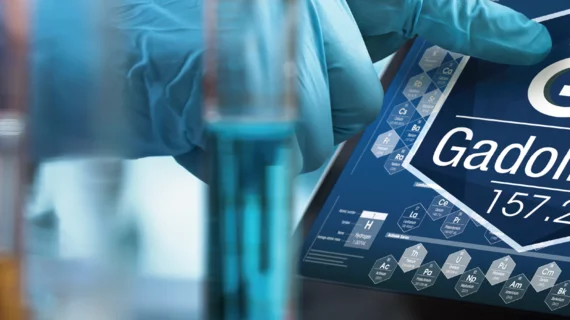Gadolinium-based contrast agents are safe, even at higher doses, new research suggests
Intravenous administration of supradiagnostic doses of gadolinium-based contrast agents revealed safe retention levels in the brain tissue of rats, according to research published Tuesday in Radiology.
MRI scans utilizing gadolinium-based contrast agents (GBCAs) enable providers to visualize injuries and diseases that would otherwise go undetected. The use of GBCAs is widely accepted and considered safe at therapeutic levels. However, researchers and government agencies have called for further investigation into the potential toxicity of gadolinium that is retained in tissue, particularly in the brain.
“The chronic toxicity of gadolinium and GBCA exposure remain undefined. Long-term retention of GBCAs within tissues provides an opportunity for dechelation, with the potential to form more biologically active forms of gadolinium,” corresponding author Jennifer S. McDonald, with the Department of Radiology at the Mayo Clinic, and co-authors explained.
To better understand how GBCA retention could impact subjects from a clinical and neurological standpoint, researchers examined its effects in 183 male rats that had been given GBCAs via intravenous administration. They compared their findings to a controlled group given saline.
The rats were evaluated six and 34 weeks after the injections. During those times, researchers did not observe any behavioral changes. “General mobility, spatial memory, short-term memory, social interactions, and balance and coordination all appeared to be unaffected by the GBCAs in our study,” the experts noted.
High concentrations of gadolinium were seen in the linear GBCA-exposed rats compared to those given macrocyclic GBCAs, with clearance rates varying based on the specific type of GBCA. Gadobutrol had the most notable clearance, while gadodiamide showed no substantial clearance. After 34-week evaluations were completed, GBCAs were nearly completely cleared in all subjects and researchers did not identify any histopathologic differences between the two groups.
“The lack of histopathologic injury in rat brain tissues exposed to GBCAs, where considerable gadolinium deposits are detected via transmission electron microscopy energy dispersive X-ray spectroscopy, reinforces preliminary findings from our group and others,” the researchers explained.
The authors note that while their results positively reflect the safety of GBCAs at supradiagnostic levels, further studies are necessary to assess the effects in humans.
Related MRI Contrast Agent Safety Content:
A deep dive into gadolinium-based adverse reactions
Allergic reactions to iodinated CT contrast increase likelihood of sensitivity to GBCAs
Researchers detail data on gadolinium-related adverse reactions
Radiologists must take a data-driven approach to discuss gadolinium, mitigate liability risk
Radiologists see potential to reduce GBCA administration with new synthetic MRI technique
Gadolinium-based contrast agents are safe, even at higher doses, new research suggests
Gadolinium debate rages on, with radiologist questioning recent GBCA liability guidance
ACR committee proposes new term for symptoms associated with gadolinium exposure
Closing the knowledge gap on gadolinium retention risks
Radiologists find direct evidence linking gadolinium-based contrast agent to higher retention rates
AI software that eliminates need for gadolinium contrast during imaging exams wins patent
Research may offer new method to detect GBCA on MRI
Radiology, other multispecialty groups urge caution with GBCAs during interventional pain procedures
Cardiac MRI contrast agents are low-risk and safe for ‘overwhelming’ majority of patients
Health orgs publish special report about gadolinium retention, GBCA use in imaging
Rodent brains retain gadolinium after repeated administration of GBCA a year after injection
Advanced MRI mapping spots traces of gadolinium in the brain invisible during conventional scanning
Radiologists should keep patients’ best interests in mind to mitigate gadolinium liability risk

